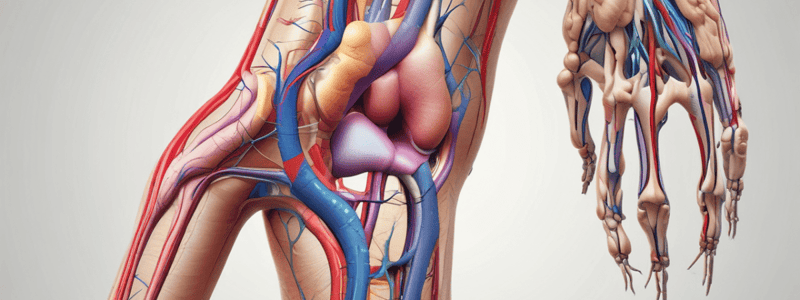Podcast
Questions and Answers
What is the main muscular deficit associated with a common fibular nerve injury?
What is the main muscular deficit associated with a common fibular nerve injury?
- Inability to plantarflex
- Inability to evert the foot
- Inability to invert the foot
- Inability to dorsiflex (correct)
Which gait abnormality is typically seen as a compensatory mechanism for 'foot drop'?
Which gait abnormality is typically seen as a compensatory mechanism for 'foot drop'?
- Pigeon-toed gait
- Circumduction gait
- Waddling gait (correct)
- Swayback gait
If left untreated, compartment syndrome may lead to:
If left untreated, compartment syndrome may lead to:
- Muscle hypertrophy
- Enhanced blood flow
- Increased range of motion
- Necrosis of affected tissues (correct)
Which nerve can be compressed deep to the inferior extensor retinaculum, leading to 'ski boot syndrome'?
Which nerve can be compressed deep to the inferior extensor retinaculum, leading to 'ski boot syndrome'?
Injury to which nerve would result in sensory deficits specific to the dorsum of the foot?
Injury to which nerve would result in sensory deficits specific to the dorsum of the foot?
How would you differentiate between a common fibular nerve injury and a deep fibular nerve injury based on motor deficits?
How would you differentiate between a common fibular nerve injury and a deep fibular nerve injury based on motor deficits?
Which nerve innervates the muscles of the posterior compartment of the leg, responsible for plantarflexion and supination/inversion?
Which nerve innervates the muscles of the posterior compartment of the leg, responsible for plantarflexion and supination/inversion?
Which nerve innervates the muscles of the lateral compartment of the leg, responsible for eversion and pronation?
Which nerve innervates the muscles of the lateral compartment of the leg, responsible for eversion and pronation?
Which nerve innervates the muscles of the anterior compartment of the leg, responsible for dorsiflexion?
Which nerve innervates the muscles of the anterior compartment of the leg, responsible for dorsiflexion?
What is the primary function of the tibial nerve during the gait cycle?
What is the primary function of the tibial nerve during the gait cycle?
Which nerve is formed by the combination of the medial sural cutaneous nerve (from the tibial nerve) and the communicating branch of the lateral sural cutaneous nerve (from the common fibular nerve)?
Which nerve is formed by the combination of the medial sural cutaneous nerve (from the tibial nerve) and the communicating branch of the lateral sural cutaneous nerve (from the common fibular nerve)?
During the swing phase of the gait cycle, which nerve is primarily responsible for the dorsiflexion of the foot?
During the swing phase of the gait cycle, which nerve is primarily responsible for the dorsiflexion of the foot?
Which nerve innervates the gastrocnemius and soleus muscles?
Which nerve innervates the gastrocnemius and soleus muscles?
Which nerve is vulnerable to injury in the clinical case described?
Which nerve is vulnerable to injury in the clinical case described?
During the stance phase of the gait cycle, which muscles are primarily active?
During the stance phase of the gait cycle, which muscles are primarily active?
Which nerve innervates the tibialis anterior muscle?
Which nerve innervates the tibialis anterior muscle?
During the swing phase of the gait cycle, which muscles are primarily active?
During the swing phase of the gait cycle, which muscles are primarily active?
Which nerve provides sensory innervation to the lateral aspect of the dorsum of the foot?
Which nerve provides sensory innervation to the lateral aspect of the dorsum of the foot?
Flashcards are hidden until you start studying




